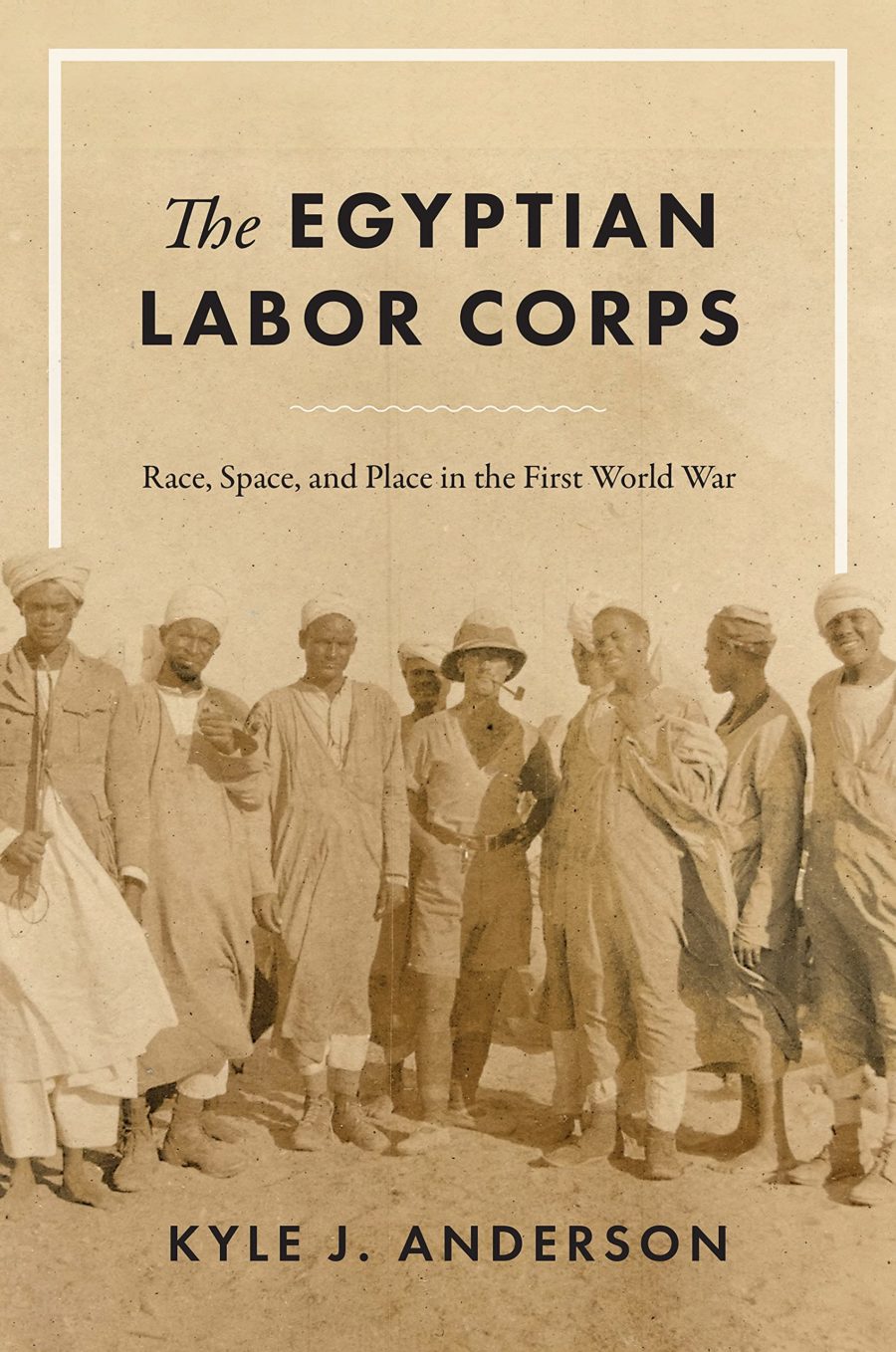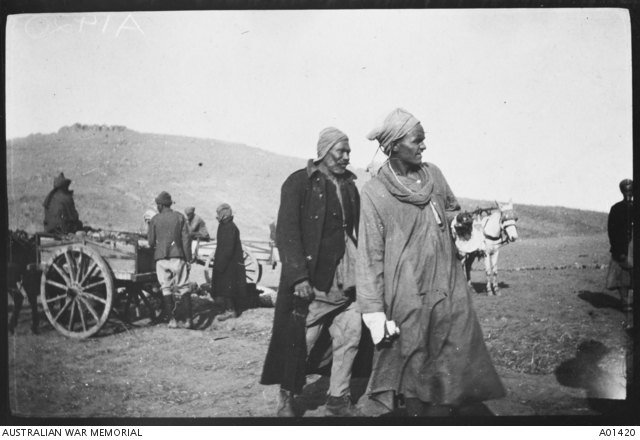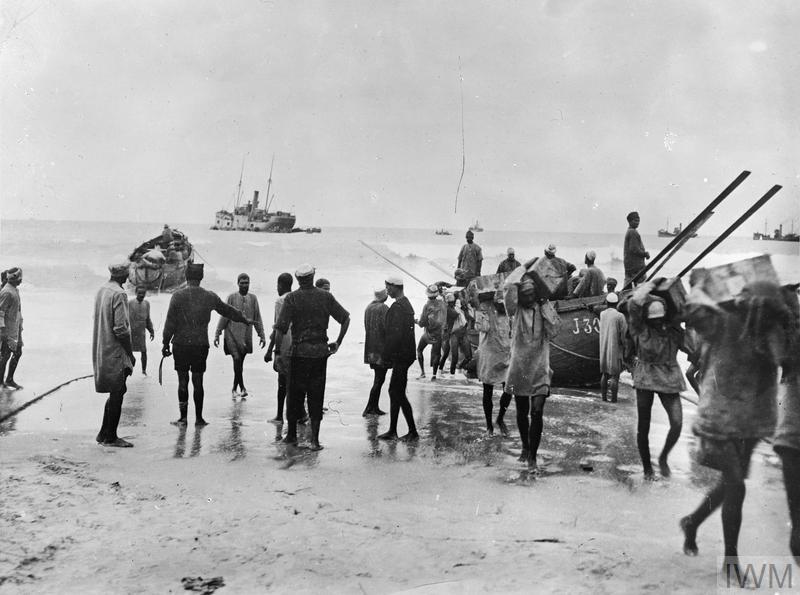 More than 600,000 Africans and Asians deployed to various European fronts. Approximately a million and a half Indians fought on behalf of the Allies.[1] The Middle East, one of the principal non-European theaters, was a “veritable Tower of Babel” due to the diversity of forces there.[2] The scale of contact across religion, race and nationality was unprecedented—and it left a mark.
More than 600,000 Africans and Asians deployed to various European fronts. Approximately a million and a half Indians fought on behalf of the Allies.[1] The Middle East, one of the principal non-European theaters, was a “veritable Tower of Babel” due to the diversity of forces there.[2] The scale of contact across religion, race and nationality was unprecedented—and it left a mark.
In the early 1920s, the librarian of the Imperial War Museum in London compiled a series of glossaries of British wartime slang abounding with English derivatives of Arabic, Chinese, Persian and Hindustani.[3] Just as much as any maps or orders of battle, these glossaries capture the profound internationalism of the war. Some words and phrases are still easily intelligible and clear, although in many instances crude. Others were so specific to the moment as to be enigmatic after more than a century.
Calm Laylas is a good example of the latter. The glossary published in November 1921 briefly notes that Calm Laylas refers to the Egyptian Labor Corps (ELC) and stems from an ELC song, “Kam Layla, Kam Yawm?” (“How many nights? How many days?”).[4] But it is only through a new book by the historian Kyle J. Anderson that the reader can begin to appreciate the significance of this military organization (and the irony of its nickname).
In The Egyptian Labor Corps: Race, Space, and Place in the First World War, Anderson recounts the involvement of the ELC in the war and its effects on Egyptian politics, recasting both through the lens of race. The ELC was not only a site of imperial racism, Anderson contends, but also a spur to racial reckoning among the Egyptian elite. He collects and connects diverse sources—including official reports, personal diaries, YMCA documents and popular Egyptian songs—to substantiate these arguments, uncovering intriguing details about the ELC and its influence on the 1919 revolution. Far from being minor historical actors, Anderson understands the men of the ELC as central to the events that wrested Egyptian independence from Britain.
Crossing the “Global Color Line”
The ELC was one of several colonial contingents in the First World War, but it dwarfed the others in size and perhaps even impact. Numbering in the hundreds of thousands at its peak, the ELC was indispensable to Britain, particularly on the Ottoman front. It was responsible for laying hundreds of miles of tracks and water pipelines across the unforgiving terrain of the Sinai Peninsula, facilitating rapid transport to Palestine and beyond. Because of the ELC, overland travel from al-Qantara (in northeast Egypt) to Jerusalem was drastically reduced from three weeks to 36 hours. In France, the men of the ELC worked in the strategic channel ports of Boulogne, Calais and Dunkirk, while in Italy they built docks and camps. ELC companies were stationed in Greece and sent to Ottoman territory, including Gallipoli, and when needed took on “emergency tasks” such as sanitation and law enforcement (89). Tested repeatedly over the course of the war, the ELC was a “tried-and-true source of labor” that strengthened the British position (34).
Yet the mobilization of Egyptians for wartime labor was not always part of British strategy. Anderson revisits the early period of the war to demonstrate how geopolitical and cultural developments intervened to bring about the ELC. As of late 1914, Egypt was still legally part of the Ottoman Empire, notwithstanding a 30-year British occupation. British officials reasoned that any maneuvers against the caliph, even after he sided with the Central Powers, could arouse “[p]an-Islamic sentiment” among Egyptians and across the empire, including in India (24). So after declaring war on the Ottomans in early November, the commander of British forces in Cairo, John Maxwell, also pledged Egyptian non-involvement. But the muted response in Egypt to a subsequent Ottoman call for jihad “emboldened British authorities” (23). By the end of the year, Britain had imposed martial law, terminated Ottoman control and established a protectorate in Egypt. The formation of the ELC soon followed.
Anderson argues that this policy change was not merely pragmatic, but also the result of racial reclassification. Prior to the war, he explains, Egyptians were viewed as Muslims, but the juxtaposition of Ottoman belligerency with Egyptian quiescence shattered this perception. In its place, Egyptians were conceived in the “late-imperial imaginary” as one of the “subject races,” a classificatory shift with practical effect (38). If Egyptians were no longer distinct from the other “people of colour” over whom Britain ruled, then British officials could use Egyptian labor as they had done elsewhere, through various wars, for over 100 years (24). Egyptians, specifically the rural fellahin, or peasants, could now be incorporated into the British reserve army of labor.
Colonial Manpower
To implement rural mobilization Britain first turned to labor contractors. These contractors had previously stepped in following the abolition of the corvée, or forced labor, in 1892. They would supply laborers, often from the countryside, for public and private projects. But as the war carried on, labor shortages (and demand) increased, causing the British and Egyptian governments to devise a new approach: “administrative pressure” (45). This pressure took the form of empowering local village officials (umad)—who were integrated into the Ministry of Interior as a result of British reforms—“to encourage the rural folk to enroll themselves” in the ELC (46).

Members of the Egyptian Labor Corps with Indian Muleteers in background, December 1915, Lemnos, Greece. Photographer unknown. Australian War Memorial collection number A01420.
But pressure could only work for so long. The umad made the most of their new authority, resorting to violence and kidnapping all while shielding their own kin and property. Locals challenged officials, sometimes staging attacks, and also petitioned the government. The situation devolved such that, in July 1918, Sultan Hussein Kamel himself complained to the British high commissioner in Egypt, Reginald Wingate. The British ultimately reinstated the corvée in hopes of rationalizing the system and limiting the “arbitrary whims” of the umad (59–60). Yet even such a reversal failed to limit their power. Despite its preponderance of military strength, the British lacked the independent capability to requisition men for the war.
Anderson traces the multiple journeys of those who actively volunteered or could not evade enlistment: from village to city, fellah to corpsman and home to the front. Recruits were housed in cramped local prisons until they could undergo “sanitary inspection” (69). If cleared, the men signed a contract, a copy of which Anderson reproduces in full in the book, committing to a period of service (six months) and payment (5 piastres a day, more than double the salary of a soldier). The extent to which they were aware of the terms is debatable; around 90 percent of men at the time were illiterate.[5] Drawing on the work of Egyptian historian Latifa Salim, Anderson explains that “those who refused to sign or put their seal on the contracts were beaten until they complied” (69).[6] At distribution camps they were given two blankets and an overcoat. One of the blankets was used to wrap their belongings when they were being disinfected. The other “served as robes during their passage to the ‘bath-house,’ where they proceeded two at a time into a large bath of fluids including cresol, soft soap, paraffin, and sulfur” (73). They were then provided their new uniform. Altogether, it took 45 minutes for a “new recruit … [to change] into a fully equipped member of the Egyptian Labour Corps,” according to one British medical officer (73). From the cities, these men departed for war.
Race and Empire
But no matter the depths of despair at war, it was the experiences of the ELC on the home front, the public brutality of recruitment, which resounded most severely and culminated in the 1919 Egyptian revolution. Anderson is not the first to make this connection, but he develops new explanations for it.[7] The first is grounded in his concept of racial nationalism. The wartime scenes of fellahin “handcuffed in iron shackles,” to quote Saad Zaghlul, whose exile in March 1919 sparked the revolution, forced a reckoning among nationalists in Egypt (170). Domestic elite antagonism toward fellahin was displaced by a romanticized adulation. The fellah became “the cornerstone of ethnic identity” in Egypt, the eternal symbol of Egyptian-ness and the “biological and cultural” connection to the Pharaonic past (160–161). By equating the fellahin and the nation, Zaghlul could point to the sacrifices and mistreatment of the ELC to demand an end to the occupation and rally support for Egyptian independence.
The second is tactical. ELC recruitment shaped not only revolutionary ideology but also militant action, which included attacks on the railways that carried men and materiel during the war. But whether the men of the ELC themselves backed these efforts is up for debate. “There is a good deal of evidence,” Anderson writes, “to indicate that actual ELC workers sometimes behaved and thought in ways that ran counter to the revolution and the postrevolutionary national project” (203–204). This behavior included establishing an ELC political party that was vocally opposed to a British withdrawal from Egypt.
The exploration of the dual processes of racial categorization—by the British and among Egyptians themselves—that animates this book takes it beyond simply a history of the ELC or Egypt to one of British imperialism itself. More than once, however, the evidentiary thread could be tighter, especially when Anderson invokes “racialization,” an organizing concept that is conspicuously missing a clear definition. Early on, for example, Anderson argues that material considerations (the opening of a new front with the Ottomans and labor shortages) insufficiently explain the reversal of the Maxwell Declaration in Egypt. He proposes instead that the war “cemented” a new racial identity for Egyptians, which inspired the policy change (38). But Anderson does not marshal adequate evidence from British archives to verify this claim. Nor does he convincingly demonstrate that British officialdom increasingly viewed Egyptians as part of the “Mohammedan race” rather than “an Ottoman-oriented ‘Islamic Civilization” (23). The only source speaking to the official mindset is a single letter from 1912, written by the consul general in Egypt, Herbert Kitchener (21–22). Kitchener was obviously larger than life, but the letter itself offers little in the way of concrete evidence.

Members of the Egyptian Labor Corps unloading supplies from surf boats at Jaffa for the British army, November 1917. George Westmoreland/Imperial War Museum
Moreover, if policy in Egypt was overridingly motivated by “race” (i.e., Islam), then why were the British not similarly hesitant to deploy troops to Europe from India—which was also grouped as Muslim according to Anderson—as early as September 1914, before the Ottomans declared war on Britain?[8] The more convincing answer, which Anderson raises and even seems sympathetic toward, is the fact that Egypt was still formally part of the Ottoman Empire when the war broke out, whereas India only maintained a religious link to it. But this would undercut his culturalist account. Race certainly shaped imperial policy, but its primacy is debatable.
These questions and takeaways reflect a general impression of The Egyptian Labor Corps: it could have benefited from more (and more apt) comparisons. There is a robust literature on minorities at war and imperial racial hierarchies, for example, much of which is left uncited. These sources could have been used to strengthen and potentially even broaden Anderson’s arguments. It is nevertheless well worth a read, especially for those interested in the legacies of empire in the Middle East.
[Gilad Wenig is a PhD student in sociology at the University of California, Los Angeles.]
Endnotes
[1] Christian Koller, “The Recruitment of Colonial Troops in Africa and Asia and Their Deployment in Europe During the First World War,” Immigrants and Minorities 26/1–2 (March/July 2008) p. 113.
[2] Eugene Rogan, The Fall of the Ottomans: The Great War in the Middle East (New York: Basic Books, 2015), p. xvii.
[3] Julie Coleman, A History of Cant and Slang Dictionaries, Volume III: 1859–1936 (Oxford: Oxford University Press, 2008) pp. 250–252.
[4] A. Forbes Sieveking, “English Army Slang as Used in the Great War,” Notes and Queries 187 (November 12, 1921) p. 383.
[5] Neil Ketchley, “Infrastructures of Revolt: Mass Politics in the 1919 Egyptian Revolution” (Unpublished Manuscript, April 7, 2022) p. 4.
[6] Latifa Muhammad Salim, Misr fi al-Harb al-ʿAlamiyya al-Ula, 1914–1918 (Cairo: al-Hayʾa al-Misriyya al-ʿAmma lil-Kitab, 1984).
[7] Report of the Special Mission to Egypt (London: His Majesty’s Stationary Office, 1921) p. 11.
[8] Koller, p. 118.
